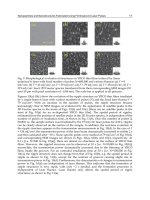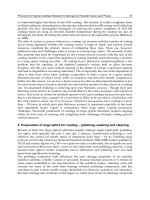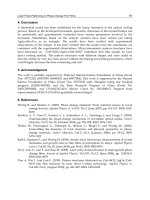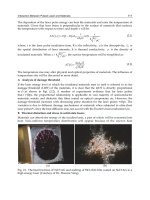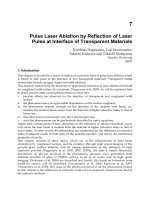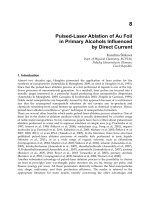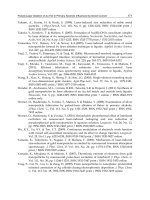Lasers Applications in Science and Industry Part 7 docx
Bạn đang xem bản rút gọn của tài liệu. Xem và tải ngay bản đầy đủ của tài liệu tại đây (3.87 MB, 20 trang )
Interaction Between Pulsed Laser and Materials
111
The deposition of the laser pulse energy can heat the materials and raise the temperature of
materials. Given that laser beam is perpendicular to the surface of materials (flat surface),
the temperature with respect to time t and depth x will be:
0
,21
2
tx
Txt R I ierfc
kC
kt
C
(2.1)
where, t is the laser pulse irradiation time, R is the reflectivity,
is the absorptivity,
0
I is
the spatial distribution of laser intensity, k is thermal conductivity,
is the density of
irradiated materials. When
4
kt
x
C
, the surface temperature will be simplified as:
0
2 It
Tt
kC
(2.2)
The temperature rise may alter physical and optical properties of materials. The influence of
temperature rise will be discussed in more detail.
A Analysis of damage threshold
If the laser energy level at which the irradiated materials start to melt is referred to as the
damage threshold (LIDT) of the materials, it is clear that the LIDT is directly proportional
to
as shown in Eqt. (2.2). A number of experiments evidence that for laser pulses
that
>10ps, the proportional relationship is applicable to vast majority of semiconductor
materials, metals, and dielectric thin films coated on optical components, etc. However, the
damage threshold increases with decreasing pulse duration for the laser pulses <10ps. The
variation is due to different damage mechanisms of materials when subjected to ultra-short
laser pulses
[4]
, since the heat diffusion does not accord with the Fourier's heat conduction law.
B Thermal distortion and stress in solid-state lasers
Materials can absorb the energy of the incident laser, a part of which will be converted into
heat. Non-uniform temperature distribution will appear because of the uneven heat
(a) (b)
Fig. 2.1. Thermal fractures of Nd:YAG and melting of SiO
2
thin film coated on Nd:YAG in a
high-energy laser (Courtesy of Dr. Huomu Yang)
Lasers – Applications in Science and Industry
112
diffusion. Consequently, expansion and contraction will lead to laser-induced thermal
stress. The stress can limit the average workable power of solid-state lasers (Fig. 2.1).
Thermo-aberration can seriously affect the uniformity of the output laser field and therefore
induce the phase distortion (Fig. 2.2).
(a)original (b) irradiated for 15min (c) distortion
Fig. 2.2. The distorted wavefront in laser heated K9 glass (The wavelength was 635nm and
Shack Hartmann sensor was used to record the wavefront distortion. Courtesy of
Dr.Yongzhao Du)
C Frequency doubling
The deposition of laser pulse energy can result in thermal depolarization in optical crystals for
doubling/tripling frequency and also degrade the efficiency of frequency doubling. Self-thermal-
effect resulting from pump loss will influence the harmonic conversion of the incident laser.
During the process of harmonic conversion, crystals inevitably absorb the energy of
fundamental frequency light and frequency-doubled/tripled light. Part of the absorbed
energy will convert into heat leading to uniform temperature rise in crystals, which will give
rise to a refractive index ellipsoid and disturb phase matching. Furthermore, harmonic
conversion efficiency will drop and the quality of output beam will deteriorate
[5]
.
2.2 Melting and solidification
With the increase of laser pulse energy, materials will absorb more laser energy and the
deposited energy will cause the material to melt in the case that materials temperature
Fig. 2.3. Morphologies of melting damage on the end surface of end-pumped fiber laser. The
material is continuously heated with repetitive pumped laser pulses and finally damaged
due to non-uniform thermal stress. (Courtesy of Dr. Xu Han)
Interaction Between Pulsed Laser and Materials
113
exceeds the melting point (Fig. 2.3). Melting followed by solidification will change the
atomic structure of materials and can realize the mutual transformation between crystalline
and amorphous state.
2.3 Ionization and gasification
Laser-induced gasification can be divided into surface gasification and bulk gasification. As
the temperature continues to increase to the vaporization point, part of the absorbed laser
energy is converted into the latent heat of evaporation, the kinetic energy of gasification and
the quality of spray steam. With increasing the laser intensity, the melted materials will be
gasified and/or ionized. The gasification is discussed based mainly on liquid-gas
equilibrium. Gaseous particles with the Maxwell distribution will splash out from the
molten layer. The gasified particles are ejected several microns away from the surface. The
space full of particles is the so-called Knudsen layer.
The ionization will greatly enhance the absorption and deposition of the laser energy. After
ionization is completed, the inverse bremsstrahlung absorption dominates the absorption of
plasma. Re-crystallization of the ionized materials may cause changes in material structure.
The damage of SiO
2
thin film coated on LiNbO
3
crystal is taken as an example (Fig. 2.4):
(a) The whole damage morphology
(b) The micro-morphology of a crater
Fig. 2.4. Damage morphologies of laser induced SiO
2
thin film. (Courtesy of Ms. Jin Luo)
Lasers – Applications in Science and Industry
114
(a) Original SiO
2
thin film
(b) Damaged SiO
2
thin film
Fig. 2.5. The XRD spectra of SiO
2
thin films on lithium niobate crystal (Courtesy of Dr.
Ruihua Niu)
Figure 2.5 (a) shows that the film without being damaged is amorphous in that no
diffraction peaks appear in the XRD spectrum whilst several apparent peaks are apparent in
Fig. 2.5 (b), indicating the appearance of crystalline silica. It can be concluded that ionization
can cause material to be re-crystallized.
2.4 Phase explosion
Phase explosion is another important thermal effect. The occurrence of phase explosion
follows the stages: the formation of super-heated liquid owing to laser energy deposition; then
the generation and growth of nucleation in super-heated liquid and explosion of nucleation.
The physical process is depicted in Fig. 2.6. Upon the irradiation of laser, the temperature of
materials will rise and the deposited energy diffuses into the bulk of materials to a certain
depth (Figure 2.6(a) ); the temperature of melted materials sharply increase to over the
boiling point due to the heavy deposition of laser energy; nevertheless, the boiling does not
start and the liquid is super-heated because of the absence of nucleation (Figure 2.6(b) ); the
disturbance will bring about nucleation and the super-heated liquid thickens as the size and
the number of bubbles grow (Figure 2.6(c)); the startling boiling will arise once the size of
bubbles is sufficiently large and afterwards the super-heated liquid and particles will be
ejected. This way, the phase explosion takes place.
Interaction Between Pulsed Laser and Materials
115
(a) (b) (c) (d)
Fig. 2.6. The generation of phase explosion
(a) (b)
5 6 7 8 9 10 11 12 13 14 15
0
50
100
150
200
250
the repetition rate (kHz)
The damage area (
m)
5 6 7 8 9 10 11 12 13 14 15
0
50
100
150
200
250
The damage area (
m)
the radius of the damage area
the depth of the damage craters
the condensation area
(c) (d)
Fig. 2.7. The damage morphology induced by different repetition rate laser pulses. (a) The
damage morphology induced by pulses with repetition rate of 5 kHz. (b) The damage
morphology induced by pulses with repetition rate of 10 kHz. (c) The damage morphology
induced by pulses with repetition rate of 15 kHz. (d) The dependence of the depth, size and
of the damaged craters on the repetition rate.
Lasers – Applications in Science and Industry
116
In order to generate phase explosion, three requirements must be met: 1. the fast creation of
super-heated liquid, the temperature of which should at least be (0.8-0.9) Tcr (Tcr is the
critical temperature)
[6]
; 2. the thickness of super-heated liquid is large enough to
accommodate the nuclear, usually on the order of tens of microns; 3. sufficient time t
c
during
which the size of nucleation reaches the critical size r
c
, generally several hundreds of
picoseconds. All the three factors are indispensable
[7]
. The generation of phase explosion
requires specific laser pulses and material properties. The power density of laser pulses
should be more than the threshold of materials (~10
10
W/cm
2
).
The phase explosion can be generated not only by single pulse but also by high-repetition
rate pulses
[8]
. Shown below are the morphologies of craters damaged with pulses of
different repetition rates (pulse energy Q= 42.7μJ, total pulse number N = 3.6 × 10
6
) 5 kHz,
10 kHz and 15 kHz, respectively (Fig. 2.7).
(a) Phase explosion damage (b) The center of the
depression pit
(c) Molten zone and the
microparticles
Fig. 2.8. Damage morphology induced by phase explosion (15kHz)
Fig.2.8(a) through 2.8(c) present the damage morphologies of materials exposed to high-
repetition pulsed laser. There exists successively micro-size particles populated region and
melting region from the center of the crater. Numerous micro-granules can be seen in the
melting region. The set of pictures imply that the material was damaged due to phase
explosion induced by the high-repetition-rate pulsed laser.
3. Effects of nonlinear interaction
Irradiated by high-intensity laser, the material exhibits a variety of nonlinear effects, such as
self-focusing, multi-photon ionization, avalanche ionization, etc. The following analyzes the
processes of small-scale self-focusing and nonlinear ionization.
3.1 Nonlinear ionization
When the laser beam of low energy is incident onto transparent material, linear absorption
happens alone. The electrons in valence band will absorb incident laser and transit from
bound states to free states when materials are irradiated with high energy lasers, which is
referred to as nonlinear ionization containing two different modes: photo-ionization and
avalanche ionization.
The band gap in dielectrics is wide and a single photon is not able to induce ionization and
the material cannot directly absorb incident laser of low intensity. Photo-ionization consists
Interaction Between Pulsed Laser and Materials
117
of multi-photon ionization (MPI) and tunnel ionization: if the electric field is strong enough
to make the electrons overcome potential barrier and ionize, the ionization is called tunnel
ionization; multi-photon ionization is the process that the electron absorbs more photons at
a time to gain enough energy beyond potential trap and to be ionized.
The Keldysh parameter can be used to classify multi-photon ionization and tunnel
ionization, depending on the frequency and intensity of the incident laser and material
band-gap
[9]
.
1
2
0 g
mcn E
eI
(3.1)
where,
is laser frequency, I is the laser intensity at focal point,
m
is the reduced mass,
e
is electron charge,
c
is the speed of light,
n
is the refractive index,
0
is material dielectric
constant,
g
E is material energy gap.
γ<1.5 tunneling γ=1.5 intermediate γ>1.5 MPI
Fig. 3.1. Schematic of photo-ionization for different Keldysh parameters.
As
1.5
the primary effect is multi-photon ionization; while
1.5
the main effect is
tunnel ionization (Fig.3.1). Both effects should be considered for the transitional state. It also
can be seen that when the material is exposed to low frequency and high power laser, tunnel
ionization plays the leading role in nonlinear photo-ionization; otherwise, multi-photon
ionization is the primary effect.
Conduction band electrons (seed electrons) in material can absorb subsequent photons to
raise its energy. When the energy of conduction band electrons rise to a certain degree, the
energized electrons can excite electrons in valance band to conduction band through
collisions with other valance band electrons and produce a pair of conduction band
electrons with lower kinetic energy. The number of conduction band electrons increases
exponentially. The above process is the avalanche ionization (Fig. 3.2).
Nonlinear ionization can cause the increase in the density of free electrons which they
strongly absorb laser energy, and in turn the density of free electrons increases sharply,
which eventually induces the laser plasma and results in breakdown damage.
Lasers – Applications in Science and Industry
118
(a) MPI (b) Avalanche ionization
Fig. 3.2. Schematic diagram of the avalanche ionization
3.2 Self-focusing
The refractive index varies accordingly with the increase of the laser density, which can be
written as
02
nn nI , where
2
00
1
2
IcnE
and
2
2
00
33
4
n
cn
.The parameter
2
n is related
to laser self-focusing and self-phase modulation. When
2
0n , the medium can be
considered a positive lens and self-focusing occurs when the beam travels through the
medium; otherwise the defocusing happens. In light of the difference in pulse duration and
nonlinear polarization time, self-focusing can be grouped into steady-state self-focusing
(continuous wave of invariable amplitude), quasi-steady self-focusing (both field and power
are functions of the delayed time), and transient self-focusing (when pulse duration is
shorter than or similar to medium response time, the medium response time must be taken
into account). In addition, the small scale self-focusing caused by the incident beam with
uneven distribution of intensity or irregular modulations can result in beam splitting,
medium filamentous damage, and spectrum detuning, etc.
Kerr lens effect is continuously pronounced with increasing the pulse power of laser and
self-focusing becomes conspicuous until the laser power approaches the critical power at
which a balance is struck between the wave-front bending caused by the diffraction and
self-focusing lens. In this way, the light beam will transmit in the form of filament (Fig. 3.3).
When self-focusing occurs, the nonlinear ionization can produce laser plasma and lead to
filamentous destruction (Fig. 3.4). In addition, the self-defocusing of laser plasma is an
obstacle to further self-focusing.
The mechanism of small scale self-focusing has been studied since early 1970s. The classical
theory is B-T theory
[10].
The B integration characterizes the size of self-focusing damage,
which is named after Breakup-integral
0
0
2
BIzdz
. B integral is a criterion for
determining the extent of small scale self-focusing and the causes of additional phase as well
as the sources of phase modulation and spectral broadening.
B-T theory remains the basic theory for nonlinear optical transmission. The world’s largest
high-power solid laser–‘National Ignition Facility’ (NIF) is designed based on B-T theory
[11]
.
Interaction Between Pulsed Laser and Materials
119
Fig. 3.3. The illustration of self-focusing filaments
(a)Filaments in crystals (b)Filaments in water
Fig. 3.4. Small-scale self-focusing. (Courtesy of Dr. Ruihua Niu and Dr. Binhou Li)
3.3 Extrinsic damage
Dielectrics have wide band-gap and low absorptive capacity and possess high intrinsic
damage threshold. However, the damage factually occurs at the laser intensity several
orders of magnitude lower than the intrinsic threshold of materials, which is due mostly
to the extrinsic damage. In other words, the impurities of the narrow band gap material
can severely lower the damage threshold of dielectrics. When impurities of narrow
band gap exist in dielectrics, the impurities can absorb laser strongly and sharply
increase energy deposition locally. The rapid deposition of laser energy can result in
melting, gasification ionization of dielectrics and laser plasma and therefore local
damage (Fig. 3.5).
Lasers – Applications in Science and Industry
120
Fig. 3.5. The ripples of SiO
2
antireflection coating due to laser damage
Fig. 3.6. The laser damage in the bulk of K9 glass (1064nm, 13.6ns) (Courtesy of Dr. Guorui
Zhou and Dr. Shutong Wang)
The self-focusing filamentous damage in K9 glass is characterized by the connection of
filamentous destruction and burst damage caused by particles that strongly absorb the laser
energy (Fig. 3.6) [12]. In high-power laser systems, the elimination of platinum inclusions in
Nd:Glass is of great importance so as to improve the damage threshold of Nd:glass
[13]
.
4. Laser induced plasma shock wave
4.1 Shock wave formation
As the laser plasma with high temperature and pressure expands outward, shock waves
will be formed. In fluid dynamics, the shock wave generated by the blast in early 1930s has
Interaction Between Pulsed Laser and Materials
121
been studied in detail and the point explosion model was proposed. Based on the model of
point explosion, zel‘dovich and Raiser systematically studied the laser plasma expansion
and developed the Sedov-Taylor instantaneous point explosion
[14]
.
Taking into account the lasting time of real explosion, the process of shock wave is
considered to consist of two stages.
1.
When
0
t
, shock wave starts due to the ablation of laser to target materials. High-
energy pulsed laser ablates and sputters the target materials to form plasma; the plasma
expands immediately and rapidly and forms shock wave. In the meantime, shock wave
continues to absorb the laser energy, which keeps expediting the shock waves.
When
0
t
, the speed of shock wave is maximized at the end of laser action. The first
stage of the formation of shock wave ends.
1
2
22
0
vv
Rt A Et t
0
t
(4.1)
where
1
2
01
v
AA
,
is the ratio of the energy transferred to shock waves to the total
energy of a laser pulse.
2.
When
0
t
, the stage is characterized with the expansion and propagation of shock
waves in the air. It is experimentally proved that shock wave eventually decays into
acoustic pulses to propagate in sonic speed in the air.
10 0 0
0
1exp
n
Rt A t k R
t
0
t
(4.2)
where
1
0
2
2
10
2
2
v
v
v
A
AEt
v
, k ,
0
, n are undetermined coefficients.
No more energy is replenished during the propagation of shock wave because the laser
irradiation discontinues. Thereby, although the radius of shock wave front keeps increasing, the
velocity of shock wave propagation slows down and the intensity of shock wave is dwindling.
4.2 Laser supported absorption wave (LSAW)
Ionized vapor can absorb partial or entire energy of the incident laser to form plasma on the
surface, so the temperature and intensity in gasification surface is the highest. A part of plasma
expands outwards and the rest is constrained within the light path, which is different from
normal gases in motion and referred to as laser supported absorption wave (LSAW)
[1]
.
The plasma is ionized in part by low energy pulses and absorbs partial energy of pulses and
the plasma shock wave propagates at the subsonic speed due to thermal conductivity,
which is laser supported combustion wave (LSCW). If the laser pulse intensity is increased,
the pressure, temperature and velocity of absorption wave increase correspondingly and the
absorptivity of wave will be further enhanced and thus the wave consumes most of the laser
energy. Then the plasma will contract and plasma propagates at supersonic speed, which is
the laser supported detonation wave (LSDW).
The LSDW damaged the target materials seriously due to its exceedingly high
temperature and pressure. Assuming that expansion process is isentropic and one-
dimensional, the velocity and pressure of plasma wave with respect to target materials
can be formulated as
[1]
:
Lasers – Applications in Science and Industry
122
2/( 1)
21
[( 1) /2 ]pp
(4.3)
2
10
/( 1)pu
(4.4)
21/3
0
[2( 1) / ]uI
(4.5)
where p
1
, p
2
and u are the pressure of LSDW on the target surface, wave rear pressure of
LSDW wave and the expansion rate of LSDW wave front, respectively,
0
is the density of
ambient atmosphere ,
is adiabatic coefficient of the plasma, I is the power density of laser
on target surface. The temperature also depends on the power density of laser pulses
[15]
.
14/( )
T
TI
,where
T
and
are constants, I is the power density of incident laser in
2
W/cm .
4.3 Effect of laser plasma spectral irradiance
Laser plasma with a very wide spectrum from ultraviolet to infrared is composed of
background continuous spectrum and linear spectrum due to elements including in the
plasma. The continuous spectrum of radiation is mainly attributed to bremsstrahlung and
recombination radiation process
[16]
. The bremsstrahlung radiation is the process that the
electromagnetic wave is emitted due to the transition of free-state to free-state contributed to
the collision between free electrons and ions. The temperature of free electron of plasma
descends quickly during the process. Recombination radiation process is the process during
which free electrons are captured to be bound-state by ions in electron-ion collision;
meanwhile excessive energy is emitted in the form of electromagnetic radiation. The
continuous spectrum with shorter wavelength and more significant intensity results from
the bremsstrahlung, while the longer can be ascribed to recombination radiation. The laser
plasma also has irradiant ionization effects. According to Keldysh ionization theory, the
shorter wavelength, the higher the photon energy and the more likely the materials will be
ionized; the short wavelength of laser plasma is much shorter than incident laser, so the
ionization effect of short wavelength laser is more apparent.
The laser plasma effects act on the materials synergically. As an example, the breakdown of
polycrystalline silicon by 1064nm focused laser beam is demonstrated in Fig 4.1. The laser
used was 18ns in pulse duration (FWHM) and 500mJ of pulse energy. The focused spot is
~150 microns in diameters.
(a) (b) (c)
Fig. 4.1. The laser induced damage in polycrystalline silicon. (a) the sputtering of laser-induced
plasma. (b) the damaged area is comprised of a crater and splashed materials. (c) the damage
morphology created with 7Hz repetition rate laser for 1s. (Courtesy of Dr. Yanyan Liu)
Interaction Between Pulsed Laser and Materials
123
The process of laser damage can be described by the action of LSDW,ionization,etc. The
results are shown as follows (Fig. 4.2).
(a) The pressure distribution of LSDW (b) Plasma spectra.
Fig. 4.2. LSDW and laser-induced plasma spectra. (Courtesy of Dr. Lingdong Bao)
The thermal and ionization cause materials to be fully melted and ionized and then the
mixture is pushed out by LSDW. The laser plasma enhances material ionization. Thus the
comprehensive effects form the damage pit surrounded by cooled material.
5. The femtosecond laser effects
Ultrashort pulse laser distinguished from nanosecond pulse laser lies in its peculiar laser-
matter mechanism, supercontiuum generation and color-center accumulation etc. Then we
will start with the ultra-short laser-matter mechanism. The ulatrafast laser refers to
femtosecond pulsed laser in this chapter unless otherwise specified.
5.1 Mechanism of interaction between femtosecond laser and matters
The pulse duration of femto-second pulse is of the order of 10
-15
s much shorter than
conventional pulsed lasers. The electrons in materials absorb the energy of incident laser
and their kinetic energy will increase. The activated electrons transfer energy to lattice by
means of electron-lattice collision. This way, the temperature of materials rises. It needs
several femtoseconds for electrons to absorb the laser energy (interactions between the
photons and electrons) and the time of electron-lattice collision is of the order of
picoseconds while lattices of materials melt within several nanoseconds.
There are plenty of free electrons in metals and semiconductors and the laser energy can be
deposited by absorbing the energy of photons directly. The laser action process can be
formulated with equation
[17]
.
2
,
e
eeei
i
iei
T
CKTgTTArt
t
T
CgTT
t
(5.1)
where, C
e
、C
I
are the heat capacity of electrons and lattices, K the conductivity of materials,
A the thermal source relating to laser pulse, g the coefficient of electron-phonon coupling.
Lasers – Applications in Science and Industry
124
The first equation represents the deposition of laser energy to electrons and the other is the
coupling of electron energy to lattices.
As to dielectrics with very low free electron density, dielectrics must be ionized by high
intensity laser. The ionization effect of femto-second laser on dielectrics can be divided into
multiphoton ionization and avalanche ionization. Then ionized electrons can absorb the
incident laser energy dramatically; however there is not adequate time for the transferring
of energy to lattices and thus the heat diffusion is impossible. By contrast, the energy in
nanosecond laser pulses has enough time to be transferred from electrons to lattices, leading
to thermodynamic damage.
Speaking generally, the craters created with femtosecond laser are smooth on the edge as
compared to nanosecond pulsed lasers (Fig. 5.1). The femtosecond laser damage is more
deterministic than ns lasers because of no obvious thermal effects and can be employed to
accurately inscribe microstructures
[18]
.
(a) ns laser pluse(13.6ns,1064nm) (b) fs laser pluse(135fs,800nm)
Fig. 5.1. The damage morphologies of SiO
2
thin film induced by nanosecond and fs laser
pulse.
5.2 Supercontiuum generation
Supercontinuum generation (SCG) is another important property of fs laser, which belongs
to nonlinear optical phenomenon. SCG involves a broad spectrally continuous output when
narrow-band incident pulses undergo extreme nonlinear spectral broadening. The SCG has
many novel applications in telecommunication, high precision frequency metrology, carrier
phase stabilization, medical imaging and pulse compression for its spatial coherence, high
brightness, and broad bandwidth
[19,20]
.
The broadband pulse propagation in waveguide can be described by the nonlinear envelope
equation. The supercontinuum generation mechanisms includes self-phase modulation
(SPM), induced-phase modulation (IPM), crossed-phase modulation (XPM), soliton effects,
Raman shift and coupling with dispersive waves, modulation instability, four wave mixing
(FWM), the main effects leading to the generation of a broad spectrum starting from a
narrow laser line.
The propagation of laser pulse in nonlinear materials can be expressed with nonlinear
Schrödinger equation
[21]
:
Interaction Between Pulsed Laser and Materials
125
23 4
12
3
24
23 4
00 0
2
22
0
(1 )
22624
()
2
R
Eic i i E Ei E
E
zn t
tt t
E
i
iEE EETE E
tt
(5.2)
where,
E is the amplitude, c the speed of light,
0
the pulse center frequency,
0
n the linear
refractive index,
2
the group velocity dispersion,
3
third-order dispersion constant,
4
fourth-order dispersion constant,
the loss coefficient. The first term describes the
diffraction and the second, third and fourth terms are material dispersion terms.
There are a variety of nonlinear media that can be used to generate wide supercontinuum,
including solids, organic and inorganic liquids and gas
[22]
. PCF (Photonic crystal fiber) has
become an important media to generate wide supercontinuum because of high nonlinearity
and low peak power pump threshold (Fig. 5.2).
Fig. 5.2. Photonic crystal fiber and supercontinuum spectrum. (Courtesy of Dr. Ping Ying
and Dr. Zairu Ma)
Lasers – Applications in Science and Industry
126
5.3 Color centers
Laser induced color center is a major type of material fatigue. It can be reduced by fs laser
with high intensity or ns laser pulse with shorter wavelength. The color centers in materials
will form if the electron-hole pairs ionized by laser are captured by defects or impurities.
Fig. 5.3. Femtosecond laser induced darkening and transmission spectrum in K9 glass
The figures 5.3 & 5.4 show the grey tracking and corresponding absorption spectra in K9
glass and KTP crystals induced by high-repetition laser pulses with wavelength of 335nm,
pulse duration of 13.6ns.
The absorption spectra exhibit several absorption peaks. The absorption at 475 nm is due to
charge transferring transitions in Ti
3+
–Ti
4+
pairs
[1]
, and the other two are due to the Jahn-
Teller effect
[23]
. For UV ns pulse, free electrons generated by single-photon ionization are the
main cause for color centers; in contrast, for fs laser, it is due to multiphoton ionization and
avalanche ionization.
Interaction Between Pulsed Laser and Materials
127
Fig. 5.4. Gray tracking in KTP crystal by 355nm laser radiation for 30min. and the
transmission spectra (Courtesy of Dr. Qiuhui Zhang and Dr. Xiang Gao)
5.4 Microstructure induced by femtosecond
Irradiated by ultra-short pulse, semiconductor or metal surface can form a variety of micro
and nano-scale structures. The micro-structures are influenced greatly by the laser pulse
parameters, such as laser pulse number, pulse wavelength, pulse energy as well as the
different external conditions (vacuum, liquid, air)
[25,26]
.We conducted preliminary
experiments on the surface periodic structure in silicon induced by repetitive femtosecond
pulses, which are in the air or water, and the results obtained are as follows (Fig. 5.5):
Lasers – Applications in Science and Industry
128
(a)
(b)
Fig. 5.5. Periodic structure on the Si surface produced in the air (a) and water (b),
respectively with femtosecond pulse (repetitive rate 10Hz, single pulse energy 1mJ,pulse
duration 35 fs, 500 pulses).
The study manifests that micro and nano-scale structure are due to the interference of the
incident light with the scattered light and/or plasma wave, while nano-particles result from
the melting and phase explosion from the shock wave.
6. Acknowledgements
This work was financed by the National Natural Science Foundation of China (Grant No.
60890203 and 10676023) and the Young Faculty Research Fund of Sichuan University (Grant
No. 2009SCU11008).
Interaction Between Pulsed Laser and Materials
129
7. References
[1] M. von Allmen and A. Blatter, Laser-Beam Interactions with Materials: Physical Principles
and Applications
, 2nd Edition, Springer-Verlag, Berlin & Heidelberg, Germany,
1995.
[2]
R. M. Wood, Laser-induced damage of optical materials, IOP Publishing Ltd., London, UK,
2003.
[3]
N. Bloembergen, “Laser-induced electric breakdown in solids,” IEEE J. Quantum.
Electron. 10, 375-386, 1974.
[4]
B. C. Stuart, M. D. Feit, S. Herman, A. M. Rubenchik, B. W. Shore, and M. D. Perry,
“Nanosecond-to-femtosecond laser-induced breakdown in dielectrics,” Phys. Rev.
B 53, 1749-1761, 1996.
[5]
H. Wang and A. M. Weiner, “Efficiency of short-pulse type-I second-harmonic
generation with simultaneous spatial walk-off, temporal walk-off, and pump
depletion,” IEEE J. Quant. Electron. 39, 1600-1618, 2003.
[6]
D. Bleiner and A. Bogaerts, “Multiplicity and contiguity of ablation mechanisms in laser-
assisted analytical micro-sampling,” Spectrochimica Acta Part B 61, 421-432, 2006.
[7]
J. H. Yoo, S. H. Jeong, R. Greif, and R. E. Russo, “Explosive change in crater properties
during high power nanosecond laser ablation of silicon,” J. Appl. Phys. 88, 1638-
1649, 2000.
[8]
J. Han, Y. Li, Q. Zhang, Y. Fu, W. Fan, G. Feng, L. Yang, X. Xie, Q. Zhu, and S. Zhou,
“Phase explosion induced by high-repetition rate pulsed laser,” Appl. Surf. Sci. 256,
6649-6654, 2010.
[9]
L. V. Keldysh, “Ionization in the field of a strong electromagnetic wave,” Sov. Phys. JETP
20, 1307-1314, 1965.
[10]
V. I. Bespalov and V. I. Tanlanov, “Filamentary structure of light beams in nonlinear
media,” JETP Lett. 3, 307-310, 1966.
[11]
“National Ignition Facility Functional Requirements and Primary Criteria,” Lawrence
Livermore National Laboratory Report NIF-LLNL-93-058, USA, 1994.
[12]
J. O. Porteus and S. C. Seitel, “Absolute onset of optical surface damage using
distributed defect ensembles,” Appl. Opt. 23, 3796-3805, 1984.
[13]
J. H. Campbell and T. I. Suratwala, “Nd-doped phosphate glasses for high-
energy/high-peak-power lasers,” J. Non-Crystal. Solids 263-264, 318-341, 2000.
[14]
Ya. B. Zel'dovich and Yu. P. Raizer, Physics of Shock Waves and High-Temperature
Hydrodynamic Phenomena
, 1966 (in Russian) [edited by W. D. Hayes and R. F.
Probstein, Dover Publications, Inc., N.Y., USA, 2002.]
[15]
T. X. Phuoc, “An experimental and numerical study of laser-induced spark in air,” Opt.
Lasers Eng. 43, 113-129, 2005.
[16]
G. Bekefi, Radiation processes in plasmas, John Wiley & Sons, Inc., N.J., 1966.
[17]
C. K. Sun, F. Vallee, L. Acioli, E. P. Ippen, and J. G. Fujimoto, “Femtosecond
investigation of electron thermalization in gold,” Phys. Rev. B 48, 12365-12368,
1993.
[18]
B. N. Chichkov, C. Momma, S. Nolte, F. Von Alvensleben, and A. Tunnermann,
“Femtosecond, picosecond and nanosecond laser ablation of solids,” Appl. Phys. A
63, 109-115, 1996.
Lasers – Applications in Science and Industry
130
[19] D. J. Jones, S. A. Diddams, J. K. Ranka, A. Stentz, R. S. Windeler, J. L. Hall, and S. T.
Cundiff, “Carrier envelope phase control of femtosecond mode-locked lasers and
direct optical frequency synthesis,” Science 288, 635-639, 2000.
[20]
I. Hartl, X. Li, C. Chudoba, R. Ghanta, T. Ko, J. G. Fujimoto, J. K. Ranka, R. S. Windeler,
and A. J. Stentz, “Ultrahigh-resolution optical coherence tomography using
continuum generation in an air-silica microstructure optical fiber,” Opt. Lett. 26,
608-610, 2001.
[21]
V. P. Kandidov, O. G. Kosareva, I. S. Golubtsov, W. Liu, A. Becker, N. Akozbek, C. M.
Bowden, and S. L. Chin, “Self-transformation of a powerful femtosecond laser
pulse into a white-light laser pulse in bulk optical media (or supercontinuum
generation),” Appl. Phys. B 77, 149-165, 2003.
[22]
J. M. Dudley, G. Genty, and S. Coen, “Supercontinuum generation in photonic crystal
fiber,” Rev. Mod. Phys. 78, 1135–1184, 2006.
[23]
M. N. Satyanarayan, H. L. Bhat, M. R. Srinivasan, P. Ayyub, and M. S. Multani,
“Evidence for the presence of remnant strain in grey-tracked KTiOPO
4
,” Appl.
Phys. Lett. 67, 2810-2812, 1995.
[24]
G. M. Loiacono, D. N. Loiacono, T. McGee, and M. Babb, “Laser damage formation in
KTiOPO
4
and KTiQAsO
4
crystals: Grey tracks,” J. Appl. Phys. 72, 2705-2712, 1992.
[25]
M. Huang, F. Zhao, Y. Cheng, N. Xu, and Z. Xu, “Origin of Laser-induced Near-
Subwavelength Ripples: Interference between Surface Plasmons and Incident
Laser,” ACS Nano 3, 4062-4070, 2009.
[26]
P. Lorazo, L. J. Lewis, and M. Meunier, “Thermodynamic Pathways to Melting,
Ablation and Solidification in Absorbing Solids Under Pulsed Laser Irradiation,”
Phys. Rev. B. 73, 134108, 2006.

